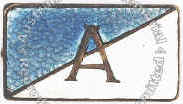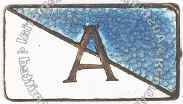| Divisional shape
, oval |
|
|
| 9th Brigade,
colour Green |
 |
|
| 10th Brigade,
colour Red |
 |
|
| 11th Brigade,
colour Saxe Blue |
 |
|
| The
first battalion in each Brigade got Black so.....the 33rd Bn
was |
 |
| The
second battalion in each Brigade got Dark Blue so...the 34th
Bn was |
 |
| The
third battalion in each Brigade got Brown so ...the 35th Bn
was |
 |
| and
the fourth battalion in each Brigade got White so...the 36th
Bn was |
 |
| Where
the senior colour and the junior colour were the same yellow
was substituted for the junior colour; refer 14th Battalion
and 46th Battalion. |
The
tradition has always been to portray the right hand patch in
illustrations where only a single patch is shown. The problem
of 'handedness' in AIF colour patches must have arisen early
in the First World War. While the issues did not concern the
First, Second, Third or Fourth Infantry Divisions at all, and
while the Fifth and the (stillborn) Sixth Infantry Divisions
needed only to turn one patch upside down to produce a
matching pair, other units, most significantly Artillery and
Light Horse, required further consideration.
- The artillery tradition
(not always adhered to) is that red
(the colour of the
flash of the gun) should
always precede blue (the
colour of the smoke from the gun).
In the case of Light Horse
Regiments, the leading and lower colour on any shoulder should
be the Brigade Colour (i.e. white for 1 ALH Brigade). In order
for the brigade colour to lead on both sleeves, the two
patches must be mirror images of each other.
 |
 |
Left &
right handed colour patches of 1 ALHR (unofficial brooch
shown) with Anzac A. |
- The crux of the matter
is that, in 1st AIF colour patches,
- the Brigade
colour should always be the leading & lower of
the two, and
- in the case of vertical
patches, the rear of
the two,
- no matter which
sleeve they are worn upon.
- Sizes:
- Rectangles:2.5"
x 1.5" (62mm x 31mm)
- Ovals:
As will fit into the same area as the rectangles
- Triangles
and Diamonds: 2" x 2" (51mm x 51mm)
|
|